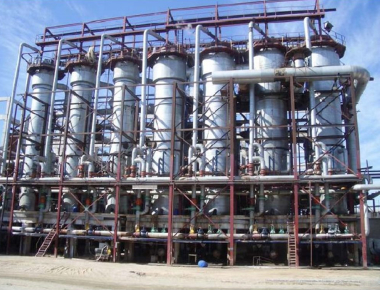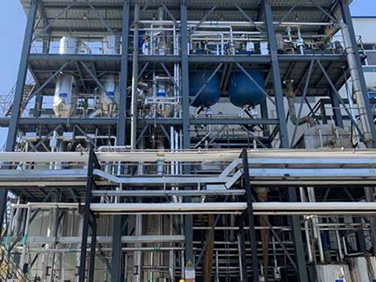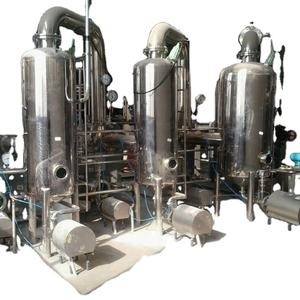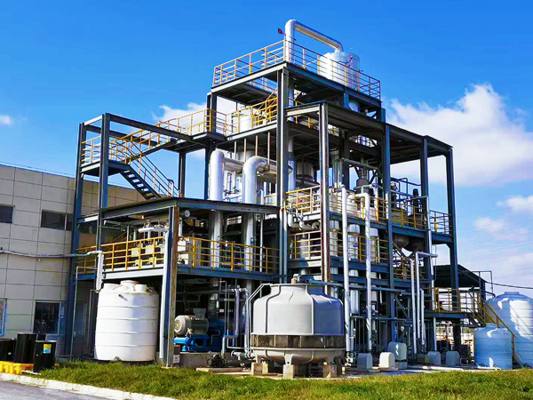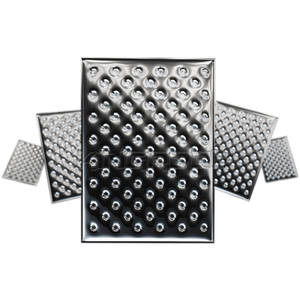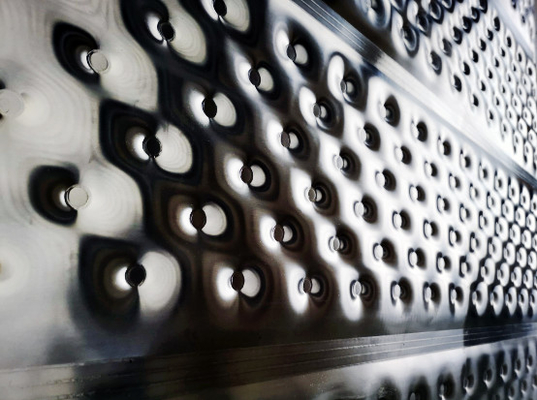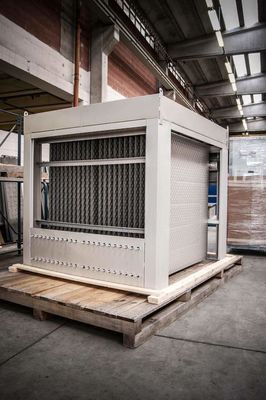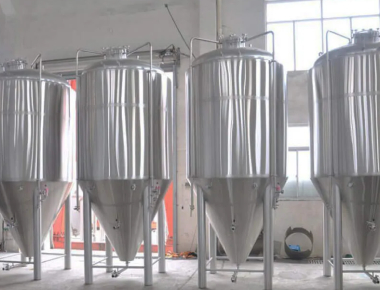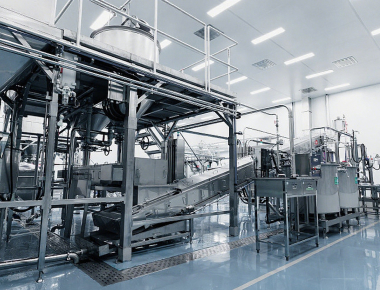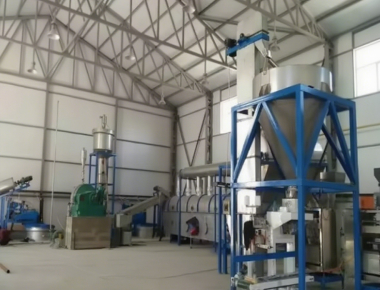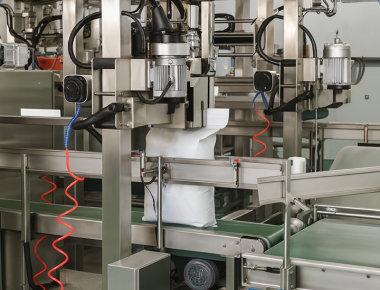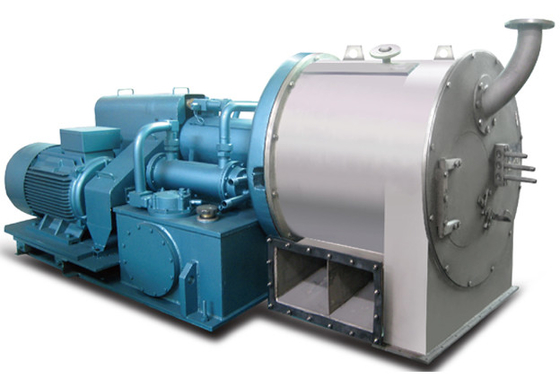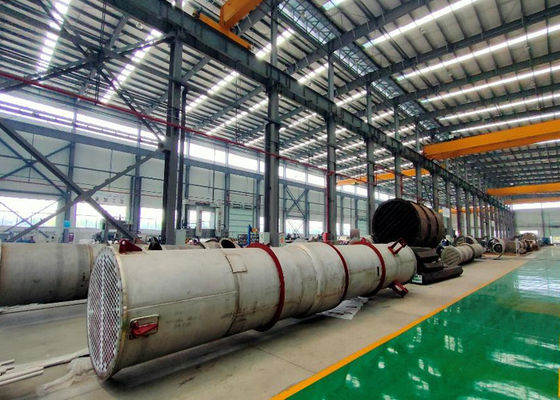Mechanical Vapor Recompression (MVR) evaporator
High Safety Level Energy Saving Mechanical Vapour Recompression MVR Evaporator
Mechanical vapor Recompression reduces the energy used in the evaporation process by up to 90% compared with conventional systems.
It works by reusing the heat energy contained in the vapor.This energy would otherwise be wasted.In a typical falling film evaporation plant the feed liquid enters the top of a vertical chamber called a Calandria.The liquid is dispersed across a large number of vertical tubes as it flows downwards it tends to form a film on the inside of the tube.Between the top and the bottom sections of the Calandria there is a sealed are where the tubes pass through a jacket of high temperature vapor.This section acts as a heating exchanger. As the hot vapor condenses on the outside of the tubes,it releases latent heat which raises the temperature of the feed liquid in the tubes.By the time the feed liquid leaves the bottom of the tube,much of the water has been evaporated off leaving a concentrated viscous liquid.The water which has been evaporated off leaves the tube as vapor.In the bottom section of the Calandria,some of the concentrated liquid gathers and can be drawn off,the hot mixture passes into a cooler chamber called the Separator where more of the concentrated liquid falls to the bottom to be drawn off and the vapor rises to the top.This vapor now contains most of the energy that was initially fed into the system.
The ExVel turbo fan sucks the vapor from the Separator and re-compresses it,raising the pressure and so increasing the temperature to the point where the vapor can once again be used as a source of heat.The ExVel unit is extremely robust,gas tight turbo fan ideally suited to the pressure,temperatures and volumes of the MVC evaporation process.At its heart is an ultra high speed impeller with a tip velocity of over 1000 Km/h faster than the speed of a jet airliner.The ExVel rotor probably has the highest tip velocity of any welded impeller ever manufactured.The re-heated vapor can then be fed back into the Calandria to provide the heat energy required to evaporate more feed liquid as it passes down the tubes.The Mechanical Vapor Compression process is a high energy efficient and cost effective way of retaining and reusing the latent heat contained in the vapor.Energy that would otherwise be wasted.Once the process has been started and brought up th temperature the only energy input required is the electricity to drive the ExVel Turbo fan.
As energy costs increase, the use of Mechanical Vapor Recompression (MVR) evaporators has also increased. The energy savings possible by using MVR technology is significant. MVR evaporators are designed to operate with very low specific energy consumption while producing clean condensate to minimize fresh water consumption in the mill.
MVR evaporators minimize energy consumption
MVR evaporators (sometimes referred to as a Vapor Compression Evaporator) removes water from mill liquors or effluents with minimum energy consumption and maximum plant availability while delivering high condensate quality.
The evaporators have lamella heating surfaces. Inherently non-foaming, these evaporators are ideally suited for the low dry solids applications of MVR evaporation with capacities from 10 to 200 t/h in a single unit.
MVR evaporators operate on a “heat pump” principle. The evaporated water vapor is recompressed with a simple, low-speed centrifugal fan or compressor which increases the saturation temperature of the vapor. After the fan, vapor can be used as heating steam in the same unit. The recompressed vapor condenses and releases its latent heat through the heat transfer surface for further evaporation of the liquor or effluent.
Mechanical Vapor Recompression MVR Evaporator consumption compared with traditional evaporation equipment calculated by evaporating 1T water
|
Name
|
Steam
|
Electric Power
|
Total Cost (RMB)
|
|
Evaporation Capacity (kg/h)
|
Consumption (T)
|
Cost (RMB)
|
Consumption (kw)
|
Cost (RMB)
|
|
|
Single Effect Evaporator
|
1.1
|
220
|
3
|
2.1
|
222.1
|
|
Double Effect Evaporator
|
0.55
|
110
|
3
|
2.1
|
112.1
|
|
Three Effect Evaporator
|
0.4
|
88
|
3
|
2.1
|
90.1
|
|
MVR Evaporator
|
0.02
|
4.4
|
30
|
21
|
25.4
|

Best possible energy efficiency
Compared to multiple-effect evaporators, MVR evaporators consume considerably less energy.
Non-foaming design
Low vapor velocities inside the evaporator, low shear rates, and the free flow falling film construction are advantages of the design in minimizing foam creation. This is especially important in MVR evaporators, not only to maximize the production of clean condensate, but also for protection of the compressor or fan.
Non-plugging design
Uniform liquor distribution of the liquor over the lamellas, and the continuous redistribution of the liquor created by the dimpled shape of the lamella surface, ensure a completely wetted heating surface and eliminate local scaling or over-concentration of liquor. The lamella heating surface ensures that water-soluble scaling can be washed away by a simple dilution wash, eliminating the need for time-consuming and costly outages for cleaning.
Cleanest condensates
Highly efficient condensate segregation in the evaporator ducts and lamellas, plus the integrated stripping of foul condensate fractions, produce clean and re-usable water.

Distillation
During distillation, liquid mixtures of substances with different vapor pressures and boiling temperatures are separated. Examples include distillation of alcohol, or the recovery and purification of solvents.

Concentration
Evaporation produces a concentration of the substance being processed. In applications such concentrated milk or fruit juice production, evaporative systems are also used as a precursor to dryers in the food industry.

Crystallization
During the crystallization process, substances are separated from one another by using different solution equilibria. Applications include salt extraction and fertilizer production.

Benefits
Very low specific energy consumption
No steam or cooling water required
Not necessary to integrate with existing evaporators
Location can be chosen relatively freely
Excellent condensate segregation
Easy capacity control
Proven in multiple applications in kraft and mechanical pulp mills

 Your message must be between 20-3,000 characters!
Your message must be between 20-3,000 characters! Please check your E-mail!
Please check your E-mail!  Your message must be between 20-3,000 characters!
Your message must be between 20-3,000 characters! Please check your E-mail!
Please check your E-mail! 
